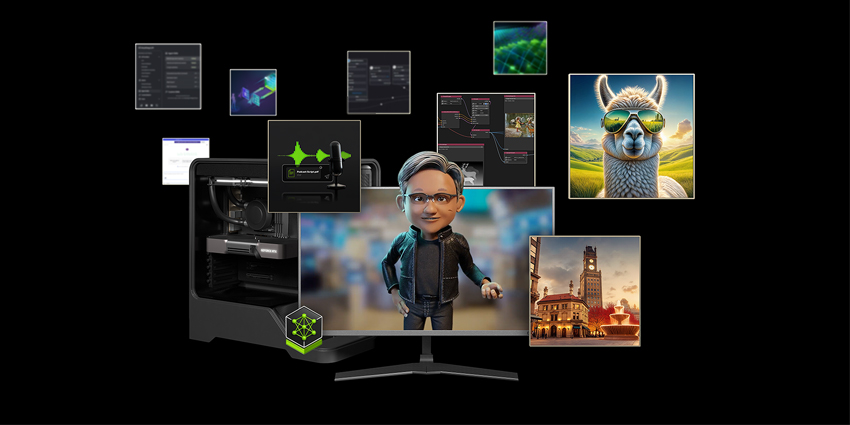CES 2025 kicked off this week. NVIDIA took centre stage during the opening keynote to showcase its latest AI innovations. The move is bold by NVIDIA, taking the industry’s first steps forward in the year to cement itself as a leader in AI.
CES is one of the most significant technology events of the year, and countless innovators are using the space to showcase the latest emerging technology. NVIDIA is trying to step ahead of the pack with various AI announcements.
NVIDIA’s AI announcements include a wide range of new frameworks to support AI agents, robotics, and simulation technology. NVIDIA also makes additional investments in its hardware division, which is empowering the next generation of AI.
At CES 2025, NVIDIA announced platforms like Groot for robotics, Cosmos for generative physical AI development, DRIVE for automotive innovations, and further Omniverse AI integrations. In addition to these latest AI launches, NVIDIA is taking the industry forward with deep hardware and agentic AI moves.
Introducing Blackwell: Project DIGITS
One of NIVIDIA’s major AI hardware announcements is the debut of Project DIGITS, an advanced personal AI supercomputer powered by the Grace Blackwell platform.
NVIDIA is launching hardware for AI experts, researchers, data scientists, and students who want to prototype, fine-tune, and operate large, complex models.
Project DIGITS leverages NVIDIA’s GB10 Grace Blackwell super chip, which offers a staggering petaflop of AI computing performance and can, therefore, handle an incredibly broad range of usages.
Jensen Huang, founder and CEO of NVIDIA, added:
AI will be mainstream in every application for every industry. With Project DIGITS, the Grace Blackwell Superchip comes to millions of developers. Placing an AI supercomputer on the desks of every data scientist, AI researcher and student empowers them to engage and shape the age of AI.
Moreover, Project DIGITS gives users access to a library of NVIDIA AI software, including software development kits, orchestration tools, frameworks, and models, to assist with development goals. NVIDIA is launching the personal supercomputer in May 2025, starting at $3,000.
Agentic AI Blueprints
A key move for NVIDIA’s AI goals is cementing its place in the booming agentic AI market. At CES 2025, NVIDIA introduced Agentic AI Blueprints for its Omniverse platform that enables the deployment of adaptive enterprise-ready AI agents in enterprise workflows.
Agentic AI blueprints provide an outline for developers to start creating bespoke AI services for their company. NVIDIA designs blueprints to suit a chosen use case while working with partners to develop further targeted agentic AI solutions.
NVIDIA AI Blueprints allow enterprise developers to leverage NVIDIA NIM microservices, NVIDIA NeMo, and agentic AI frameworks from a collection of partners to deploy custom AI agents in a workplace pipeline. Agents could assist with automated analysis and summarizations of large data quantities to create real-time insights from video, PDF, and multiple other data sources.
One of NVIDIA’s first-party agentic AI blueprints includes its PDF-to-podcast AI framework, which helps developers deploy agents and turns PDFs into easily digestible AI-generated readouts.
NVIDIA also works with expert AI partners such as CrewAI, Daily, LangChain, LlamaIndex, and Weights & Biases, each providing a blueprint to help developers create suitable services.
Moreover, Accenture is joining the NVIDIA agentic AI journey to accelerate the ability of enterprise developers by deploying 12 targeted AI agents that cover usage in sectors such as telecommunications, insurance claims underwriting, legacy modernization for banking, revenue growth management for consumer goods and services, clinical trial companion for life sciences, industrial asset troubleshooting, and B2B marketing.
Accenture believes in the blueprint framework, as it plans to introduce up to 100 industry-ready AI agents in the future.
According to NVIDIA, the platform will suit various enterprise sectors, including automotive, technology, manufacturing, factory management, and consumer goods. The net is seemingly cast-wide thanks to NVIDIA’s first and third-party portfolio of agentic AI blueprints.
NVIDIA notes that agentic AI moves beyond current AI chatbot interactions and expectations by allowing enterprise developers to integrate agents to tackle complex, multi-step problems.
NVIDIA is also supporting its Agentic AI Blueprints platform with an orchestration system. The firm is designed to help manage, monitor, and coordinate multiple AI agents working on a shared process.
Further Advancements of NVIDIA Agentic AI
In addition to the various agentic AI blueprints now available from NVIDIA, the firm is looking to simultaneously supercharge this agentic journey with new, open, large language models.
NVIDIA NIM microservices developers can use L0lama Nemotron large language models and Cosmos Nemotron vision language model to provide AI-powered services such as customer support, fraud detection, and product supply chain and inventory management features.
For example, using the supporting framework, enterprise developers can build AI agents to generate AI protocols for various use cases by creating real-time assessments of images and video from business environments, including autonomous machines, hospitals, stores, and warehouses.
Ahmad Al-Dahel, vice president and head of GenAI at Meta, added:
Agentic AI is the next frontier of AI development, and delivering on this opportunity requires full-stack optimization across a system of LLMs to deliver efficient, accurate AI Agents. Through our collaboration with NVIDIA and our shared commitment to open models, the NVIDIA Llama Nemotron family built on Llama can help enterprises quickly create their own custom AI agents.
Already, with AI Blueprints services, leading platform providers such as SAP and ServiceNow are working to leverage the supercharged agentic AI models.
Philipp Herzig, chief AI officer at SAP, also added:
AI agents that collaborate to solve complex tasks across multiple lines of the business will unlock a whole new level of enterprise productivity beyond today’s generative AI scenarios. Through SAP’s Joule, hundreds of millions of enterprise users will interact with these agents to accomplish their goals faster than ever before. NVIDIA’s new open Llama Nemotron model family will foster the development of multiple specialized AI agents to transform business processes.
“The improved performance and accuracy of NVIDIA’s open Llama Nemotron models can help build advanced AI agent services that solve complex problems across function, in any industry,” explained Jeremy Barnes, vice president of platform AI at ServiceNow.








